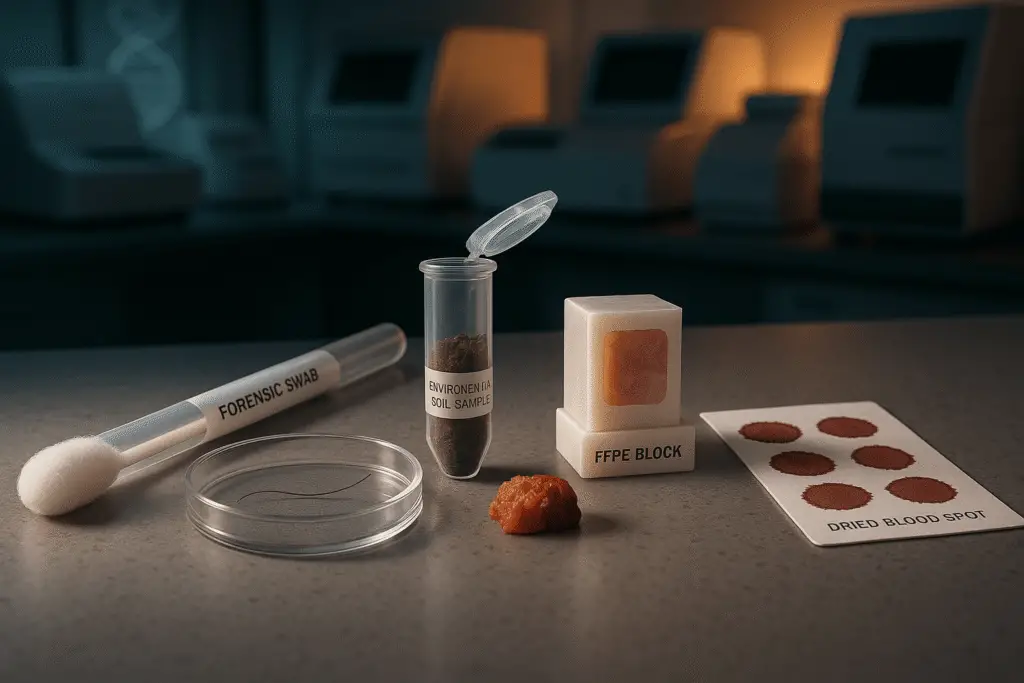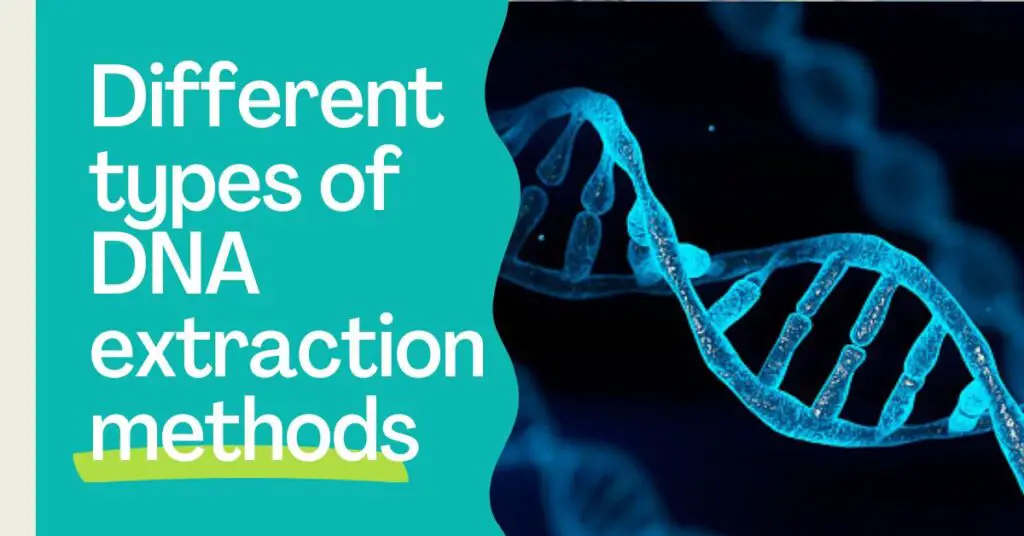“Explore our complete, well-researched and comprehensive guide on how to extract DNA from low-volume or microvolume samples.”
If you’ve worked in a molecular biology lab, you already know — DNA extraction is kind of our bread and butter. It’s something we get so used to doing that it almost feels automatic after a point.
But that comfort usually comes when we’re dealing with decent sample volumes — enough blood, tissue, or cells to work with. Things get tricky when the sample is super limited.
Think of a tiny drop of blood, a minuscule biopsy, or an old degraded forensic sample. That’s when something so routine suddenly turns into a real challenge.
Working with low-volume samples requires more than just following a protocol — you need to be extra careful, precise, and sometimes creative.
And in fields like forensics, clinical diagnostics, ancient DNA studies, or single-cell research, low-volume samples are often all you get. So, figuring out how to extract usable DNA from them is absolutely essential.
Explore our comprehensive and thoroughly researched guide on extracting DNA from low-volume samples.
Stay tuned.
Key Topics:
What is a low-volume sample?
Now, the first question we need to address is, what is a low-volume sample? Which types of samples are considered low volume?
The biological sample available in a very minute or smaller quantity is known as a low-volume sample, for example, a dried blood spot or hair follicle. It is typically ~50 µL in volume or between 1 and 5 mg in mass.
In usual conditions, adequate biological material is available or advised for DNA testing. However, low-volume samples are often collected when
- Sample collection is difficult.
- Only trace material is available.
- The sample is partially degraded.
- To minimize the invasive procedure.
- In the case of a crime scene or accident.
Various types of low-volume samples are listed in the table below.
| Sample | source | Volume/mass |
| Dried blood spot | Heel prick, finger prick | ~5–20 µL |
| Tear fluid/sweat | Non-invasive biomonitoring | <5 µL |
| saliva | Children, dry mouth conditions | <100 µL usable saliva |
| Buccal swab | Forensic, neonatal, self-collection | ~100 µL |
| Nasal swab | Respiratory sample collections | picogram–nanogram range |
| Small tissue biopsy | Endoscopic or needle biopsies | 1–5 mg |
| Hair follicle | Wildlife studies, ancestry testing | 1-2 hairs |
| Forensic swab | Surfaces, skin, degraded stains | picogram–nanogram range |
| FFPE microsections | Pathology archives | <1 mm slices |
| Single cells | Flow-sorted or microdissected cells | femtogram–picogram DNA |
General DNA protocols we use in laboratories are optimized for a decent volume of sample. For example, 100 to 1000 µL of blood. However, such protocols can’t work effectively for low-volume samples, studies suggest.
DNA extraction from such low-volume samples is a challenging task, indeed. Advanced kits, instruments and optimizations are required to handle such samples and obtain DNA.
When do we get low-volume samples?
For routine diagnostics and research, the sample we collect or obtain is adequate enough to proceed with DNA extraction. Even for a repeat extraction. The scenarios in which we have to deal with the LVS are explained below.
Forensic science:
Forensic experts often deal with low volume and compromised biological samples or traces. These samples are,
- Dried blood stains on clothing or weapons
- Touch DNA — skin cells left behind on door handles, cell phones, or jewelry
- Hair strands (with or without roots)
- Saliva traces on envelopes or drinkware
- Degraded samples from older crime scenes or exposed remains
Clinical diagnosis:
The emergence of minimally invasive diagnostics uses minimal or low-volume samples to extract DNA. These samples are,
- Dried blood spots (DBS) from heel pricks in newborn screening
- Capillary blood samples for at-home genetic testing kits
- Tiny tissue biopsies from cancer patients or prenatal testing
- Bodily fluids like tears or cerebrospinal fluid, collected in microliters
In addition, wildlife and conservation, and ancient remains are also considered low-volume samples, which pose additional challenges to DNA extraction.
Why is it difficult to extract DNA from LVS?
There are multiple reasons that make the whole process of LVS DNA extraction tedious and challenging.
Low yield and copy numbers:
The LVS are fewer in quantity. Meaning, it yields very low DNA or copy numbers. Such DNA can’t be obtained differently with standard protocols or optimizations.
Degraded DNA:
Aged samples, such as ancient remains, often contain degraded or fragmented DNA. This decreases the DNA yield due to environmental pressure and yields low-quality and quantity DNA.
Contaminants and inhibitors:
Low quantity samples are often rich in contaminants and inhibitors. Such elements pose hurdles in downstream analysis, such as PCR or DNA sequencing.
No precipitates:
DNA extracted from an adequate sample can be precipitated and visualized. However, LVS can’t be seen, although it is precipitated. This is because of the very low quantity.
How to extract DNA from the low-volume samples?
Now, let’s come to the point: how to extract DNA from LVS? Here, some of our suggestions and optimizations that work for these types of samples.
With some minute modification in our native protocols like phenol, chloroform and isoamyl alcohol or proteinase K, DNA can be extracted from LVS like blood spot, dried spot or tissue block. However, additional care must be taken while handling the sample.
Note that if you use the PCI protocol, add an additional step of proteinase K digestion to achieve maximum yield of DNA.
Take care of minute procedures like pipetting, mixing or centrifugation to minimize the likelihood of sample waste or errors.
Add an RNase treatment step in the protocol to remove RNA contamination if any.
Use a DNA purification method to remove impurities and yield extra pure DNA. impurities contain contaminants and inhibitors to inhibit PCR or sequencing.
Studies showed that TRI reagent works excellently with the LVS. TRI Reagent solution (also sold as TRIzol) is a mixture of guanidine thiocyanate and phenol in a monophase solution that is used for the isolation of DNA, RNA and protein from biological samples.
I strongly recommend using a ready-to-use kit, automation or magnetic bead-based DNA extraction technique. This ensures a high yield of DNA.
Recent Research and Protocols:
Bramucci et al. (2021) proposed two novel techniques for isolating DNA from the microvolume environmental samples. They extracted DNA from an extremely low volume seawater sample (1 µL).
They employed a physical lysis using the alkaline/sock + thermal treatment (KOH + dithiothreitol), and chemical lysis using lysozyme, proteinase K and SDS. Purification has been performed using AMPure magnetic beads for 100 µL, 10 µL, and 1 µL samples.
The sample has been used for metagenomics shotgun sequencing.
Farivar & Ghazimoradin (2019) extracted DNA from the low volume blood samples (2, 5, 10 and 20µL) using the TRI reagent. The protocol is explained here.
- Transfer 2, 5, 10, or 20 µL of blood into a 2 ml tube.
- Add equal volume of TRI reagent immediately.
- Pipette to mix thoroughly.
- Centrifuge at 12,000 × g for 5 min at 4 °C.
- Separate DNA-containing clot (pellet) from RNA-containing supernatant.
- Add 10 µL chloroform to the clot.
- Vortex for 2–3 min.
- Centrifuge at 12,000 × g for 15 min at 4 °C.
- Discard aqueous phase, if present.
- Transfer the remaining supernatant to the PCR tube.
- Add 10 µL cold 100% methanol, incubate 5 min at 4 °C.
- Centrifuge at 2,000 × g for 5 min.
- Discard supernatants.
- Resuspend the pellet in 10 µL of 75% cold ethanol.
- Incubate 30 min.
- Air dry the pellet.
- Add 5 µL DEPC-treated water to dissolve DNA.
After completion of the article, I will provide the link to the article. You can refer to the article for more details.
Sarnecka et al. (2019) processed microvolume FFPE tissue samples (~5 µM in size) using QIAamp DNA FFPE tissue kit, Cobas DNA sample preparation kit and Maxwell 16 FFPE Plus LEV DNA Purification kit from QIAGENE, Roche and Promega, respectively.
Their results showed that all kits yield excellent DNA from FFPE tissue samples, although the Cobas DNA extraction kit yields a slightly higher amount of DNA.
Khafaei et al. (2021) proposed a protocol for extracting DNA from the hair samples (hair shaft). Their complete procedure is summarised here.
- Instrument bleaching (5% chlorine), rinsing and UV-irradiating (60 min).
- Hair sterilizationwith sodium hypochlorite, rinsed, and UV-exposed (10 min).
- Add 300 μL lysis buffer + 50 μL proteinase K.
- Digest hair with lysis buffer and proteinase K at 56°C for 2 hours.
- Centrifuge at 4000 RPM for 5 minutes.
- Add 5M NaCl and an equal volume of chloroform, vortex briefly.
- Centrifuge at 14,000 RPM. Discard the aqueous supernatant, retain for ethanol precipitation.
- Add cold 100% ethanol (2 volumes) to the supernatant.
- Incubate at −20°C for 1 hour.
- Centrifuge at 14,000 RPM for 10 minutes.
- Discard supernatant, retain pellet.
- Add 5% Chelex solution and Tris buffer to the pellet.
- Incubate at 56°C for 1 hour.
- Centrifuge at 3000 RPM for 1 minute.
- Transfer supernatant to new microtube.
- Add cold ethanol (100%), centrifuge at 14,000 RPM for 5 minutes.
- Discard supernatant, let pellet air-dry.
- Resuspend the final pellet in 50 μL of distilled water.
Wrapping up:
Extracting DNA from low volume or microvolume isn’t rocket science. You need to have a strategy, a decent knowledge of DNA extraction and years of experience handling such samples.
In conclusion, LVS are common in forensics, cancer research, ancient DNA and environmental DNA studies. If you belong to any of these subjects or want to pursue your career in any one of these, you have to learn and handle LVS.
Click links and check out our previous articles on DNA extraction, ancient DNA studies and environmental DNA studies. Till then, share this article and subscribe to Genetic Education.
Sources:
Bramucci, A.R., Focardi, A., Rinke, C. et al. Microvolume DNA extraction methods for microscale amplicon and metagenomic studies. ISME COMMUN. 1, 79 (2021). https://doi.org/10.1038/s43705-021-00079-z.
Farivar, S., & Ghazimoradi, M. H. (2019). DNA and RNA extraction from low amount of blood volume. Forensic Science International, 303, 109931. https://doi.org/10.1016/j.forsciint.2019.109931.
Sarnecka AK, Nawrat D, Piwowar M, Ligęza J, Swadźba J, Wójcik P. DNA extraction from FFPE tissue samples – a comparison of three procedures. Contemp Oncol (Pozn). 2019;23(1):52-58. doi: 10.5114/wo.2019.83875. Epub 2019 Mar 26. PMID: 31061638; PMCID: PMC6500389.
Khafaei, M., Sadeghi, M., Zargari, P., Saadatmand, F., Barouei, R., & Mohammadi, A. (2021). An Effective Method for Extracting DNA From Human Hair Samples. Journal of Applied Biotechnology Reports, 8(2), 141–145. https://doi.org/10.30491/jabr.2020.117890.


